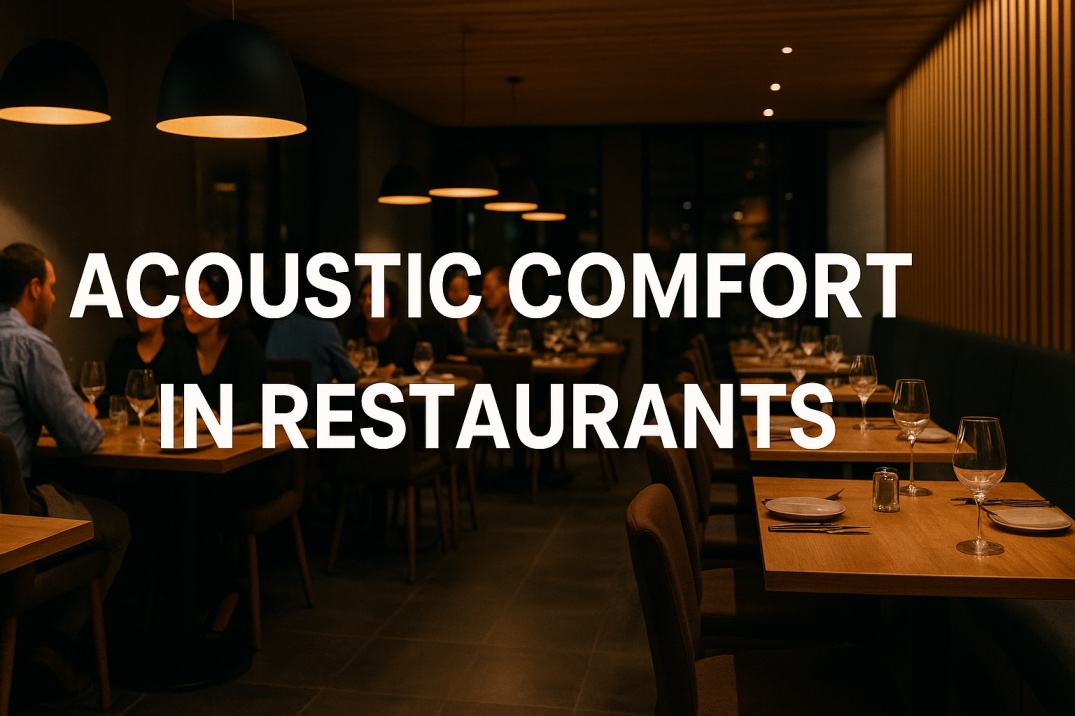News
Creating Acoustic Comfort in Restaurants: The Overlooked Ingredient of a Perfect Dining Experience

Step into any lively eatery on a Friday evening, and the first thing that strikes you is the vibrant din. The clinking of plates, mingling voices, and the soft murmur of tunes create a lively atmosphere that can transform even the finest dining into a somewhat overwhelming affair. Many diners may not recognize that what they perceive as a “bad vibe” or “excessive energy” frequently arises from inadequate acoustic design. In the realm of hospitality, sound holds equal importance to flavor, lighting, and décor, intricately influencing the overall dining experience in both subtle and impactful manners.
Why Acoustic Design Matters More Than You Think
When restaurant owners design their interiors, they often focus on visual appeal — considering elements like furniture, colorschemes, and lighting. Sound frequently takes a backseat, regarded as a trivial aspect rather than a fundamental element of the design ethos. Research consistently indicates that noise levels exceeding 70 decibels can elevate stress hormones, hinder concentration, and diminish the overall enjoyment of dining experiences.
The implications for the staff are significantly more pronounced. Regularly being around high noise levels can result in tiredness, anxiety, and potential long-term hearing problems. From a business perspective, high noise levels do more than disrupt comfort; they can hinder table turnover, escalate complaints, and negatively influence online reviews.
In straightforward terms, designing an acoustically pleasant environment goes beyond mere aesthetics; it’s a savvy business move.
Understanding the Science of Sound in Restaurants
To enhance acoustics, it is essential to first grasp the dynamics of sound within an environment. In dining establishments, the majority of the noise stems from chatter, the sounds of the kitchen, and ambient systems such as ventilation or music. Hard surfaces like concrete, glass, and metal bounce sound waves, enhancing echoes and reverberation. Soft materials such as carpets, curtains, or acoustic panels effectively absorb sound.
Two core concepts define acoustic design:
Sound Isolation vs. Sound Absorption
Sound isolation involves the techniques used to stop sound from escaping or entering a space, which is particularly beneficial in environments like recording studios or multi-unit dwellings.
Conversely, sound absorption aims to minimize reverberation in an environment. In the realm of dining, the main objective is to fully engage the senses. The goal is to preserve a subtle vibrancy without allowing it to spiral into chaos.
The Ideal Acoustic Balance
Each dining establishment possesses a unique equilibrium — a harmonious blend of vibrancy and relaxation. Avoid creating an atmosphere so quiet that it seems devoid of life,yet ensure that your guests can comfortably converse without straining to hear one another. Achieving effective restaurant acoustics involves finding the right balance, managing reverberation time while preserving a lively ambiance.
Materials That Define Acoustic Excellence
Selecting the appropriate materials is essential for achieving effective sound design. Each restaurant has its unique character, and solutions must align with its layout, size, and aesthetic aspirations.
Acoustic Panels and Ceiling Solutions
Contemporary acoustic panels are available in numerous styles — ranging from sleek, understated designs that seamlessly integrate with ceilings to vibrant, artistic installations that make a statement. Suspended acoustic clouds and baffles effectively absorb sound while maintaining an open and uncluttered ceiling aesthetic. Numerous upscale dining establishments incorporate them into their lighting schemes, successfully blending aesthetics with practicality.
Flooring and Carpeting Choices
Carpets inherently soak up sound, softening the jarring effects of footsteps and the shifting of furniture. For dining establishments that favor hard flooring, utilizing acoustic underlays or strategically placed area rugs can provide comparable advantages while maintaining the desired visual appeal.
Wall Treatments
Walls frequently go unnoticed, yet they serve as prime opportunities for enhancing acoustics. Perforated wooden panels, felt wall coverings, and even living plant walls can greatly diminish reflections while introducing a delightful tactile warmth.
Sustainable Acoustic Solutions
Sustainability transcends mere trendiness; it is fundamentally influencing contemporary restaurant design in all aspects — acoustics included. Modern restaurants focused on sustainability are selecting materials that harmonize acoustic quality with a commitment to the environment.
Recycled and Renewable Materials
Acoustic panels crafted from recycled PET bottles, wool, or bamboo are gaining traction in today’s market. They offer excellent sound absorption while also reflecting a brand’s commitment to sustainability, attracting diners who are conscious of environmental issues.
Durability Equals Sustainability
Endurance is a key aspect of sustainability. Durable acoustic materials are designed to endure, effectively fend off moisture and dust, and minimize the need for frequent replacements. This resilience leads to enduring financial benefits and a reduced ecological impact — a triumph for both the environment and the bottom line.
Aesthetics Meets Functionality: Design Integration
Perseverance plays a crucial role in achieving sustainability. Robust acoustic materials are crafted to last, efficiently resist moisture and dust, and reduce the frequency of necessary replacements. This perseverance results in lasting financial advantages and a diminished ecological footprint — a victory for both nature and profitability.
Invisible Integration
Acoustic plasters, micro-perforated ceilings, and fabric-covered walls now offer the ability to absorb sound while maintaining the look of standard surfaces. Numerous designers choose acoustic art panels that serve as both functional sound management solutions and striking decorative elements, transforming the way we perceive sound control into a focal point of design.
Flexible and Modular Systems
Dining establishments transform over time. Adapting to seasonal layouts, hosting event nights, or shifting décor themes demands a certain level of flexibility. Modular acoustic systems enable managers to effortlessly rearrange sound-absorbing components. Flexible panels, adjustable baffles, and retractable ceiling systems enable restaurants to adjust seamlessly without the need for costly renovations.
Technology’s Growing Role in Acoustic Design
Technology has transformed every sector — and acoustics is certainly no exception. Intelligent systems are currently employed to oversee and enhance auditory environments in real time.
Smart Sensors and Adaptive Systems
Smart acoustic systems utilize microphones and sound sensors to assess the existing noise levels, enabling them to modify background music, speaker volumes, or even the intensity of lighting as needed. This guarantees a steady, inviting atmosphere all day long — from serene brunches to bustling dinner crowds.
Virtual Acoustic Simulation
Designers are increasingly employing software tools to craft virtual acoustic models of restaurant interiors prior to construction. These simulations forecast the behavior of sound within the environment, enabling precise adjustments to materials and configurations prior to the installation of any panels. It’s an economical and precise method for designing acoustic comfort.
The Human Factor: Health, Comfort, and Wellbeing
The essence of humanity continues to be at the forefront, transcending mere design and technology. Acoustic comfort transcends simple noise reduction; it encompasses both mental and physical wellness.
For Guests: A Better Dining Experience
Excellent acoustics facilitate seamless and organic conversations. Visitors extend their stays, increase their orders, and show a greater tendency to come back. The feeling of tranquility and focus elevates the experience of quality even the flavors of food are more enjoyable when individuals are at ease.
For Staff: Productivity and Retention
In the bustling atmosphere of a restaurant, chefs, servers, and bartenders dedicate countless hours to their craft. Consistently elevated noise levels can lead to increased stress and eventual burnout. Minimizing background noise fosters a more conducive work environment, resulting in enhanced service quality and greater employee satisfaction.
Backed by Science
Studies in environmental psychology indicate that pleasant soundscapes can reduce cortisol levels, enhance concentration, and foster social engagement. Acoustic comfort plays a crucial role in enhancing the ultimate aim of hospitality — fostering genuine human connections.
The Economic Perspective: Sound as a Business Investment
Investing in acoustics is not merely a cost; it’s a strategic move for growth. Establishments that prioritize superior soundscapes often experience tangible benefits, including enhanced customer satisfaction, increased repeat patronage, and favorable reviews.
Excessive noise often ranks high on the list of grievances shared on restaurant review sites. Tackling this issue not only enhances the atmosphere but also plays a crucial role in managing reputation, boosting sales, and fostering long-term loyalty.
ROI Through Comfort
A more tranquil setting fosters extended visits and increased average spending. When guests feel at ease, they are more inclined to stay for dessert, coffee, or perhaps another glass of wine. Conversely, the weariness from noise frequently leads to premature exits and a decline in orders.
Employee Retention
The expenses associated with turnover in the hospitality sector can be quite significant. A tranquil work environment leads to reduced absenteeism and enhanced morale among employees. Enhancements in acoustics yield benefits in both income and lower personnel expenses.
Common Challenges and Modern Solutions
Despite increasing awareness, numerous restaurant owners continue to face challenges in adopting effective sound solutions, often hindered by design limitations or budgetary restrictions.
Open Layout Dilemmas
While open kitchens and expansive dining halls possess a certain charm, they are often plagued by excessive noise. In these situations, implementing acoustic zoning—through ceiling baffles, half-walls, or varied materials in designated areas—effectively balances noise distribution and preserves energy in an orderly manner.
Retrofitting Existing Spaces
Established eateries frequently encounter limitations due to their architectural heritage. Fortunately, contemporary materials such as peel-and-stick acoustic tiles or tensioned fabric systems enable enhancements without the need for extensive renovations.
Balancing Ambience
Music significantly influences the atmosphere, yet it can swiftly overshadow discussions. It’s essential to align the tempo and volume of music with the number of people present, ensuring that clarity and balance across frequencies are preserved.
Real-World Examples of Acoustic Transformation
Numerous esteemed dining establishments across the globe have demonstrated how thoughtful acoustic design enhances the overall experience of a meal.
In Amsterdam, sleek bistros feature wool-covered panels that resemble artistic wall displays. In Tokyo, cozy sushi bars feature wooden lattices that soften sound while preserving a clean aesthetic. Scandinavian cafés frequently utilize felt-lined seating and natural fiber panels to foster a cozy, subdued atmosphere that aligns with their design principles.
These examples illustrate that acoustics involve more than just quieting a space; they are about shaping its rhythm.
Getting Started with Acoustic Improvements
Restaurant proprietors looking to enhance their auditory atmosphere should begin with a thorough professional acoustic evaluation. Professionals can assess reverberation time, pinpoint sound reflection areas, and suggest customized materials. Collaborating with experts in restaurant acoustics guarantees that the outcomes are not only practical but also seamlessly blend with the restaurant’s overarching concept.
FAQs About Acoustic Comfort in Restaurants
1. What’s the ideal noise level for restaurants?
Many specialists suggest keeping ambient noise levels within the range of 55 to 65 decibels. This fosters engaging dialogue that feels effortless and enjoyable.
2. How can small restaurants manage noise on a budget?
Cost-effective solutions encompass the addition of fabric drapes, wall tapestries, and rugs, as well as the installation of modular acoustic panels in crucial reflection zones such as ceilings and parallel walls.
3. Can I add soundproofing after the restaurant is built?
Yes. A variety of acoustic solutions can be seamlessly integrated with little disturbance by utilizing adhesive panels, hanging baffles, or stretch-fabric systems.
4. Do acoustic materials affect interior aesthetics?
Not necessarily. Contemporary offerings are available in a variety of customizable hues, forms, and finishes that not only match but can also elevate the aesthetic of your dining establishment.
5. Why do acoustics matter for staff?
Minimizing background noise enhances communication, alleviates fatigue, and creates a more serene atmosphere, ultimately boosting both safety and morale.
6. Are sustainable materials as effective as traditional ones?
Certainly. A variety of eco-friendly panels, including those crafted from recycled PET or wool, can match or even surpass the acoustic performance of synthetic materials.
7. How long does it take to install acoustic treatments?
Typically, the installation process for restaurants can be wrapped up within a few days to a week, influenced by the scale and intricacy of the design.
Designing for the Ears, Not Just the Eyes
Exceptional dining experiences captivate all the senses, flavor, visual appeal, aroma, and texture. However, sound frequently goes overlooked, despite its significant impact on the overall experience. Acoustic comfort transcends mere silence; it embodies clarity, balance, and a sense of emotional tranquility. Through careful acoustic design, restaurant owners can significantly improve guest comfort while simultaneously boosting their brand image, supporting employee wellbeing, and ensuring sustainable profitability.
Ultimately, an exceptional dining establishment offers more than just exquisite cuisine; it resonates harmoniously as well.
-

 Social Media2 months ago
Social Media2 months agoWhat the “67” TikTok Meme Really Means
-

 Tech2 months ago
Tech2 months agoWhat To Do When Your Business Faces Network Vulnerabilities
-

 Self Improvement2 months ago
Self Improvement2 months agoUsing BCBS Rehab to Access Quality Addiction Care
-

 Games2 months ago
Games2 months agoPusoy Strategies for Play That Also Work in Pusoy Dos in English






